| Author |
Message |
|
Tim Lison
|
 Posted: Thu 07 Jun, 2012 9:13 pm Post subject: Posted: Thu 07 Jun, 2012 9:13 pm Post subject: |
 |
|
Oh, hell yes! That is just GREAT!  I'm dripping with envy right now... I'm dripping with envy right now...
|
|
  |
 |
William Swiger

|
 Posted: Thu 07 Jun, 2012 11:47 pm Post subject: Posted: Thu 07 Jun, 2012 11:47 pm Post subject: |
 |
|
Absolutely Beautiful. 
|
|
  |
 |
Zach Luna

|
 Posted: Fri 08 Jun, 2012 12:15 am Post subject: Posted: Fri 08 Jun, 2012 12:15 am Post subject: |
 |
|

|
|
   |
 |
|
Jeremy V. Krause
|
 Posted: Fri 08 Jun, 2012 7:42 am Post subject: Posted: Fri 08 Jun, 2012 7:42 am Post subject: |
 |
|
|
I'm going to save my laudations until she is arrayed in her final finished glory. . . .
|
|
  |
 |
J.D. Crawford

|
 Posted: Fri 08 Jun, 2012 5:20 pm Post subject: Posted: Fri 08 Jun, 2012 5:20 pm Post subject: |
 |
|
| Jeremy V. Krause wrote: | | I'm going to save my laudations until she is arrayed in her final finished glory. . . . |
Me too, but I'm having a hard time holding off, especially after that last set of photos!
|
|
   |
 |
J.D. Crawford

|
 Posted: Sat 09 Jun, 2012 7:51 am Post subject: Posted: Sat 09 Jun, 2012 7:51 am Post subject: |
 |
|
Here are a couple more I didn't have time to post the other day.
 Attachment: 19.23 KB Attachment: 19.23 KB
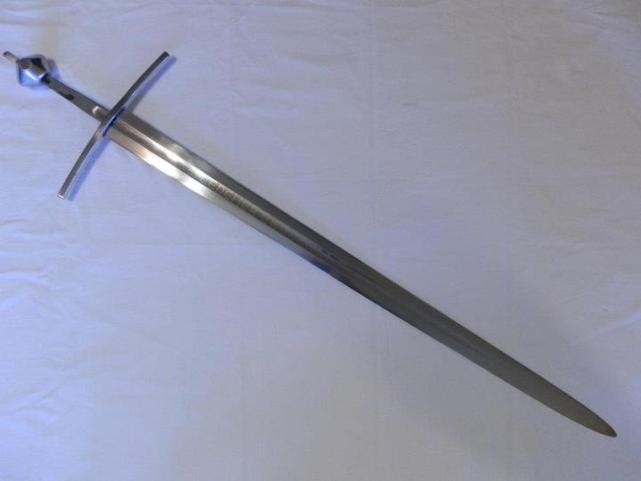
 Attachment: 73.37 KB Attachment: 73.37 KB
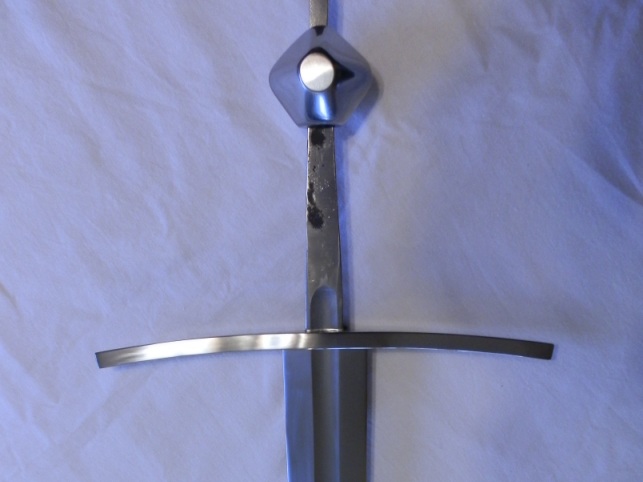
|
|
   |
 |
Julien M

|
 Posted: Sat 09 Jun, 2012 9:14 am Post subject: Posted: Sat 09 Jun, 2012 9:14 am Post subject: |
 |
|
| J.D. Crawford wrote: | | Julien, have you been to this museum? It looks like a really nice collection. I don't know why their swords aren't better known. |
Hi JD. No have not been...but planning to for a while, as the Musée de l'Hôtel Sandelin is located in the very north of France, close by the channel so in fact not so far from south London by car+ eurotunnel. I'll cross the channel this summer so will likely go on my way down to Brittany.
I guess these swords are not better known most likely because there has not been much published/academic works featuring them, and that's too bad because they have some great pieces indeed, such as the 3 pieces below...
Cheers,
J
 Attachment: 23.7 KB Attachment: 23.7 KB
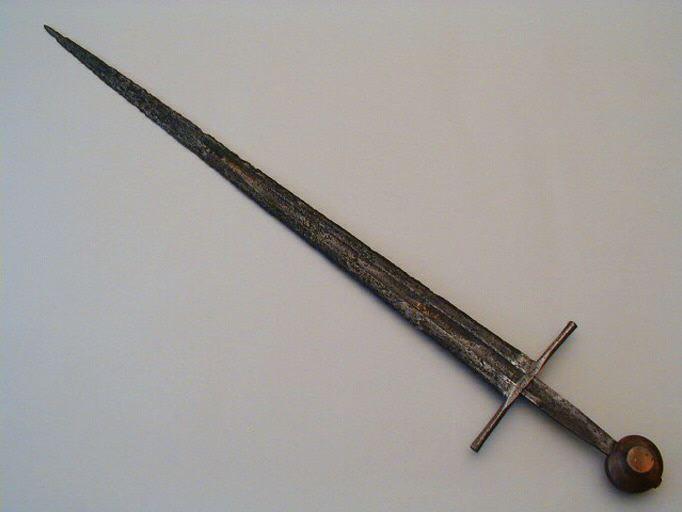
 Attachment: 28.25 KB Attachment: 28.25 KB
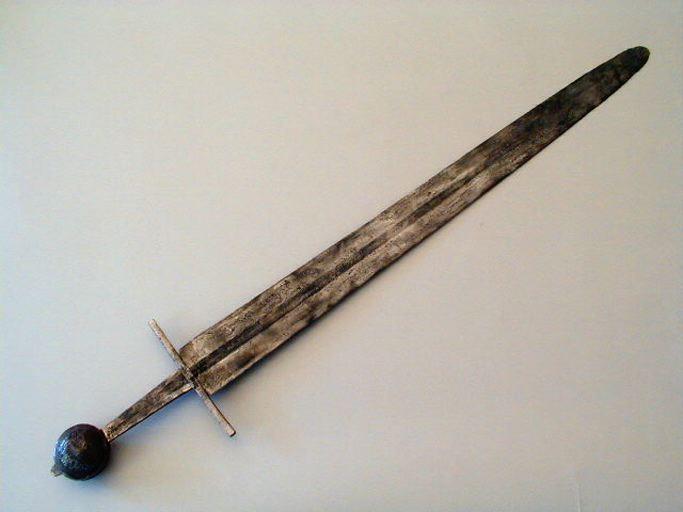
 Attachment: 26.48 KB Attachment: 26.48 KB
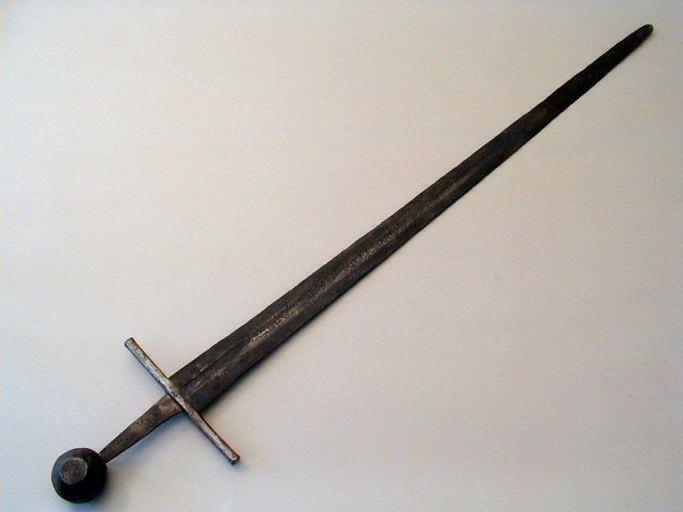
|
|
  |
 |
Luka Borscak

|
 Posted: Sat 09 Jun, 2012 9:17 am Post subject: Posted: Sat 09 Jun, 2012 9:17 am Post subject: |
 |
|
|
Pommel is great, I really like these unusual pommels. I would like to see an example of type S pommel (cube with corners cut of) and I think it would suit well to a big XII like this, or maybe XIII or XIIIb...
|
|
  |
 |
J.D. Crawford

|
 Posted: Sat 09 Jun, 2012 10:24 am Post subject: Posted: Sat 09 Jun, 2012 10:24 am Post subject: |
 |
|
| Julien M wrote: | | Hi JD. No have not been...but planning to for a while, as the Musée de l'Hôtel Sandelin is located in the very north of France, close by the channel so in fact not so far from south London by car+ eurotunnel. I'll cross the channel this summer so will likely go on my way down to Brittany. |
If you do, please take and post some pictures!
BTW, I also thought of comissioning the interesting XIIIb you showed, but decided its too close the the Tritonia sword which I already have. There is something about the overall proportions of the 'pyramid pommel' sword currently being replicated that really speaks to me, I just had to get that one done. Very happy with how its turning out.
|
|
   |
 |
J.D. Crawford

|
 Posted: Mon 11 Jun, 2012 6:40 pm Post subject: Posted: Mon 11 Jun, 2012 6:40 pm Post subject: |
 |
|
I'm hoping to get the final pictures of this sword soon, but in the mean time a few more words on the inscription and possible date.
There are several similarities between this sword and the 'Whittlesea Mere' sword, better known as Xa.4 in Oakeshott's records: http://collections.vam.ac.uk/item/O67956/sword-unknown/
First of all, there are some general similarities in the blade form and size (35" VS. 34 3/4").
More interesting is the similarities in the inscription: + NEDEHER+EWEDENI + (vs.) +NEDASEDNGRED...
(see the original of the sword reconstructed here at: http://moteur.musenor.com/application/moteur_...mAuteur=1)
Both blades were apparently inlayed in yellow metal. There are some similarities in the content, especially the first three letters. More important is the style of the letters. Both with the same style of cross at the start (and maybe end). Both have an odd mix of round 'E's and square 'E's (Jeff chose to stick with the round 'E's on his version for stylistic reasons). Both have the same odd 'N' with a flat portion at the base. Could these have come from the same workshop?
The official museum date for the Whittlesea sword is 1250-1300, but Oakeshott dated it much earlier (~1100) on the basis of similarity of the inscription with that of some swords found by Leppaho in Finish grave sites.
[Its also notworthy that the Whittlesea sword bears much in common (hilt components, blade profile, yellow metal inscription) with the more famous double fuller River Witham sword at the British Museum (Tim posted a picture of this above, and see http://www.britishmuseum.org/explore/highligh...ord.aspx). The official date for this sword is 250-1330, but again Oakeshott dates it two centuries earlier.]
The more I look at Jeff's version of the NEDEHER+EDWEDENI sword, the more I'm convinced that the original was earlier than 14th century. With its similarities to the Whittlesea Mere sword inscription, I am now convinced that this sword dates to the 13th century, or even earlier, depending on the date you accept for the Whittlesea Mere sword.
Last edited by J.D. Crawford on Tue 12 Jun, 2012 8:53 am; edited 1 time in total
|
|
   |
 |
Luka Borscak

|
 Posted: Tue 12 Jun, 2012 4:16 am Post subject: Posted: Tue 12 Jun, 2012 4:16 am Post subject: |
 |
|
|
All 3 of these swords are obviously related, and if they are related to Leppaho finnish swords that would put them to about 1100. That might be but I wouldn't say that is true for their fittings. Leppaho swords have fittings typical for the end of the 11th and beginning of the 12th century (except for that octagonal pommeled one) and this sword from Sandelin have fittings too typical for 13th and 14th century and Whittlesea Mere and British Museum swords also have fittings more typical of later times than 1100. So while their blades may have been made in about 1100 by the same workshop and inlayed by the same man or a few of them copying their letters from the same model, I doubt their fittings are from the same time. They were either long used and rehilted later or maybe blades weren't used for a long time but lay in some storage and were hilted long after they were made.
|
|
  |
 |
J.D. Crawford

|
 Posted: Tue 12 Jun, 2012 6:09 am Post subject: Posted: Tue 12 Jun, 2012 6:09 am Post subject: |
 |
|
| Luka Borscak wrote: | | All 3 of these swords are obviously related, and if they are related to Leppaho finnish swords that would put them to about 1100. That might be but I wouldn't say that is true for their fittings. Leppaho swords have fittings typical for the end of the 11th and beginning of the 12th century (except for that octagonal pommeled one) and this sword from Sandelin have fittings too typical for 13th and 14th century and Whittlesea Mere and British Museum swords also have fittings more typical of later times than 1100. So while their blades may have been made in about 1100 by the same workshop and inlayed by the same man or a few of them copying their letters from the same model, I doubt their fittings are from the same time. They were either long used and rehilted later or maybe blades weren't used for a long time but lay in some storage and were hilted long after they were made. |
Yes Luka, that is certainly a possibility that I have considered as well. It could be an earlier blade with later hilt components. Although the pommel on the Sandelin sword is so unique (apparently one of a kind) that it helps little in dating. It looks like an elaboration of the disc type and its tempting to think that a more complex type comes later, but that is not always the case (as in Viking swords, where simplified forms often came later). It may not be a 'type' at all but rather a one-time artistic flourish. The long cross definitely looks later, but is not unknown in earlier swords.
Another possibility is that the inlay styles found by Leppaho continued in use through the 12th and 13th centuries. That would render Oakeshott's whole dating system for early medieval swords, largely based on Leppaho's finds, invalid.
On the balance, I feel that the Sandelin sword (and the other two swords mentioned above) date to the 13th century.
|
|
   |
 |
Robin Smith

|
 Posted: Tue 12 Jun, 2012 6:43 am Post subject: Posted: Tue 12 Jun, 2012 6:43 am Post subject: |
 |
|
| J.D. Crawford wrote: | | Luka Borscak wrote: | | All 3 of these swords are obviously related, and if they are related to Leppaho finnish swords that would put them to about 1100. That might be but I wouldn't say that is true for their fittings. Leppaho swords have fittings typical for the end of the 11th and beginning of the 12th century (except for that octagonal pommeled one) and this sword from Sandelin have fittings too typical for 13th and 14th century and Whittlesea Mere and British Museum swords also have fittings more typical of later times than 1100. So while their blades may have been made in about 1100 by the same workshop and inlayed by the same man or a few of them copying their letters from the same model, I doubt their fittings are from the same time. They were either long used and rehilted later or maybe blades weren't used for a long time but lay in some storage and were hilted long after they were made. |
Yes Luka, that is certainly a possibility that I have considered as well. It could be an earlier blade with later hilt components. Although the pommel on the Sandelin sword is so unique (apparently one of a kind) that it helps little in dating. It looks like an elaboration of the disc type and its tempting to think that a more complex type comes later, but that is not always the case (as in Viking swords, where simplified forms often came later). It may not be a 'type' at all but rather a one-time artistic flourish. The long cross definitely looks later, but is not unknown in earlier swords.
Another possibility is that the inlay styles found by Leppaho continued in use through the 12th and 13th centuries. That would render Oakeshott's whole dating system for early medieval swords, largely based on Leppaho's finds, invalid.
On the balance, I feel that the Sandelin sword (and the other two swords mentioned above) date to the 13th century. |
I'm fairly certain Leppaho's finds are dated on the basis of all the objects in the grave as well as the burial customs, not just the sword. While I certainly think this sword here is later, atleast in final construction/hilting I don't think you can say that about the Leppaho sword.
A furore Normannorum libera nos, Domine
|
|
   |
 |
|
Jeremy V. Krause
|
 Posted: Tue 12 Jun, 2012 6:48 am Post subject: Posted: Tue 12 Jun, 2012 6:48 am Post subject: |
 |
|
Hi J.D.
Considering dating on your sword, we might also want to look at the development of the letter "W", which has an odd genesis in Germanic and Old English.
I have been looking it up a bit but haven't really gotten very far. Some sources say that the full "W" could have been used in 1100 but others say that either a "P" like letter or a "uu" would be used, even in to the 13th. c. in early German.
I know it's an odd angle to take in dating but given the reletive peculiarity of "W" I was thinking we might get somewhere.
|
|
  |
 |
Robin Smith

|
 Posted: Tue 12 Jun, 2012 7:00 am Post subject: Posted: Tue 12 Jun, 2012 7:00 am Post subject: |
 |
|
| Jeremy V. Krause wrote: | Hi J.D.
Considering dating on your sword, we might also want to look at the development of the letter "W", which has an odd genesis in Germanic and Old English.
I have been looking it up a bit but haven't really gotten very far. Some sources say that the full "W" could have been used in 1100 but others say that either a "P" like letter or a "uu" would be used, even in to the 13th. c. in early German.
I know it's an odd angle to take in dating but given the reletive peculiarity of "W" I was thinking we might get somewhere. |
Interesting angle. The P like letter is probably the "Wynn rune", and atleast in Middle English its gone within a few generations of the Norman Conquest.
http://en.wikipedia.org/wiki/Wynn
I know that doesn't help with Early High German, but its a data point to consider.
A furore Normannorum libera nos, Domine
|
|
   |
 |
|
Jeremy V. Krause
|
 Posted: Tue 12 Jun, 2012 7:19 am Post subject: Posted: Tue 12 Jun, 2012 7:19 am Post subject: |
 |
|
| Robin Smith wrote: | | Jeremy V. Krause wrote: | Hi J.D.
Considering dating on your sword, we might also want to look at the development of the letter "W", which has an odd genesis in Germanic and Old English.
I have been looking it up a bit but haven't really gotten very far. Some sources say that the full "W" could have been used in 1100 but others say that either a "P" like letter or a "uu" would be used, even in to the 13th. c. in early German.
I know it's an odd angle to take in dating but given the reletive peculiarity of "W" I was thinking we might get somewhere. |
Interesting angle. The P like letter is probably the "Wynn rune", and atleast in Middle English its gone within a few generations of the Norman Conquest.
http://en.wikipedia.org/wiki/Wynn
I know that doesn't help with Early High German, but its a data point to consider. |
As far as I can remember, the sword being reproduced here has the only "W" I can think of in an inlay of extant examples of the period 900-1300.
|
|
  |
 |
J.D. Crawford

|
 Posted: Tue 12 Jun, 2012 8:59 am Post subject: Posted: Tue 12 Jun, 2012 8:59 am Post subject: |
 |
|
| Robin Smith wrote: | | I'm fairly certain Leppaho's finds are dated on the basis of all the objects in the grave as well as the burial customs, not just the sword. While I certainly think this sword here is later, atleast in final construction/hilting I don't think you can say that about the Leppaho sword. |
Sorry Robin, I didn't mean to imply that Leppaho was wrong in dating his swords. But rather that the styles of inlay observed on his swords could have persisted for some time, thus invalidating Oakeshott's reliance on such comparisons for firm dating. There is such a huge gap between Oakeshott's dates and some of the standard museum dates; someone has to be wrong.
Jeremy, I tried looking at the original 'W' but can't see it very well in the museum picture. Maybe Vikverir has a better picture but I don't have time in the office to go digging through them right now. Please let me know if you see something that provides a further clue!
I'm learning a lot about inlay from this project!
|
|
   |
 |
J Helmes
Industry Professional

Location: Lanark Highlands Ontario Canada Joined: 06 Mar 2009
Posts: 120
|
 Posted: Wed 13 Jun, 2012 2:13 am Post subject: Posted: Wed 13 Jun, 2012 2:13 am Post subject: |
 |
|
| Jeremy V. Krause wrote: | Hi J.D.
Considering dating on your sword, we might also want to look at the development of the letter "W", which has an odd genesis in Germanic and Old English.
I have been looking it up a bit but haven't really gotten very far. Some sources say that the full "W" could have been used in 1100 but others say that either a "P" like letter or a "uu" would be used, even in to the 13th. c. in early German.
I know it's an odd angle to take in dating but given the reletive peculiarity of "W" I was thinking we might get somewhere. |
I have just been looking at the text of Hartmann Von Aue's "Iwein" said to be from around 1203 and written in middle high German, and it appears to use the letter w.
|
|
   |
 |
|
Peter Johnsson
Industry Professional
|
 Posted: Wed 13 Jun, 2012 3:25 am Post subject: Posted: Wed 13 Jun, 2012 3:25 am Post subject: |
 |
|
The Witham sword in the British Museum also has a "W" in its inscription.
When we discussed this, I was told by Silke Ackermann, that this letter may point at an south german origin for the blade and that it could date from the early 13th century.
-This is if my memory is to be trusted.
:-)
|
|
   |
 |
J.D. Crawford

|
 Posted: Wed 13 Jun, 2012 6:08 am Post subject: Posted: Wed 13 Jun, 2012 6:08 am Post subject: |
 |
|
This is the best picture I can get for the 'W' on the orginal sword Jeff is working from. It looks very square at the bottom compared to our modern W. Any thoughts on what this might mean?
 Attachment: 10.76 KB Attachment: 10.76 KB
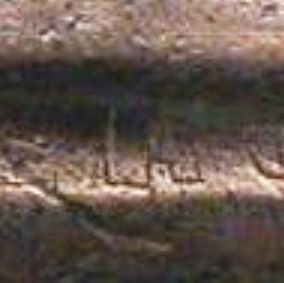
|
|
   |
 |
|
|
You cannot post new topics in this forum
You cannot reply to topics in this forum
You cannot edit your posts in this forum
You cannot delete your posts in this forum
You cannot vote in polls in this forum
You cannot attach files in this forum
You can download files in this forum
|
All contents © Copyright 2003-2024 myArmoury.com — All rights reserved
Discussion forums powered by phpBB © The phpBB Group
Switch to the Basic Low-bandwidth Version of the forum
|

